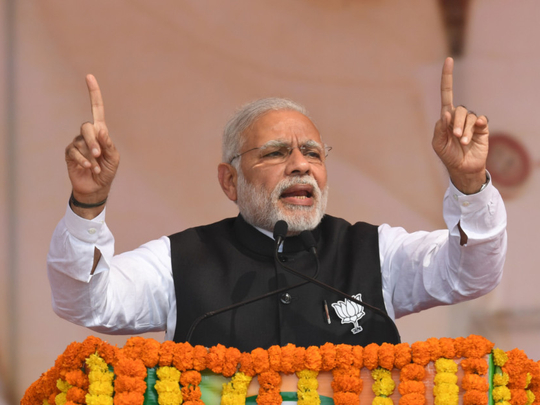
Recently, a ruling Bharatiya Janata Party (BJP) minister made disparaging remarks about Mahatma Gandhi and then went on to say that Indian Prime Minister Narendra Modi is a better brand name that Mahatma Gandhi for khadi, a hand-woven cloth, which was close to the heart of the Mahatma. This raised a firestorm, for khadi is not just a cloth, it represents a whole movement, a socio-cultural aesthetic that goes to the very core of India’s independence struggle. He also delivered a near-seditious prophesy, saying Modi’s image will shortly replace that of the Mahatma on currency notes and this would enhance the value of the Indian rupee just as khadi sales had gone up after Modi became its brand ambassador.
The minister has since retracted his statements, but the country’s liberals will not let go. They accuse Modi of being responsible for this insidious personality cult. For the record, fawning on leaders is integral to Indian political culture. Years ago, another flatterer, had said this of former Indian prime minister Indira Gandhi: “India is Indira, Indira is India.” Yet, Modi gets withering criticism, in part, because of his muscular persona, his public posturing — including his sartorial preferences and frequent references to the rage and shame felt by Hindus, whether under British or Muslim rule. In Madison Square Garden, New York, in front of adoring Indian–Americans, Modi said to a thunderous applause: “Our ancestors used to play with snakes. Now we play with the mouse.” The tech-savvy crowd lapped it up, cheering him on. He moves deftly between nativism and internationalism, but ancient India and its Hindu culture is underlined in his speeches.
Two essays, one by Siddhartha Deb in the New Republic and another by Shiv Visvanathan in the Deccan Chronicle, explore these themes, painting a very dark and ugly portrait of Modi. In Deb’s ‘Unmasking of Modi’ he says, violence, insecurity and rage in the man has replaced Gandhi as the face of the nation. The new face of India is anti-Gandhi.
Visvanathan’s ‘Dividing lines’, is equally scathing and tells us of how Modi is aiming to be ubiquitous, ever-present in our daily lives and this ties in well with die-hard Modi fans wanting to put him on currency notes. It is a different matter that currency notes were far from ubiquitous during the recent demonetisation drive. But the more telling remark by Visvanathan is: “Modi, after having sampled the possibilities of playing national heroes like Jawaharlal Nehru and others, tries Gandhi.”
Historian Ramachandra Guha has held that in contemporary India, one historical figure that can be co-opted, used and misused without fear and retribution is Mahatma Gandhi. The Father of the Nation belongs to everyone and no one. Jawaharlal Nehru is too closely identified with the Congress, Netaji Subhas Chandra Bose is too much of a Bengali hero for anyone else to lay claim to. Only Gandhi stands apart, no sect can singularly own him. There is no well-defined constituency for the Mahatma, no vote bank for him, anyone can write anything on him, in favour or against without the fear of being injured and hounded. Yes, there will be the customary outcry, but nothing after that. One BJP leader went so far to say that Gandhi and his assassin are both patriots. After the routine hue and cry, the matter has been forgotten and this very same leader is BJP’s star campaigner in the upcoming assembly elections in the key state of Uttar Pradesh.
Given this, it would seem that this substitution of image on currency notes and the khadi calendar were not a random suggestion. The minister was testing the waters for a bigger image makeover. A rewriting of history itself, a more elaborate, subterranean and calibrated effort by the Hindu Right to reinvent itself. In the post-truth world and alternative facts, the new script has to invent facts to fit the revised narrative. The Achilles heel for the Hindu Right has always been its role during the freedom movement. The Rashtriya Swayamsevak Sangh (RSS), the spearhead of the Hindu Right, never took an active part in this struggle and many of its newer and younger admirers, born much after independence, are blissfully unaware of this fact.
So is it possible that, Modi, an ardent RSS worker during his early political career, is doing his bit to re-arrange and even reimagine history. A picture speaks a thousand words. The front page of this controversial khadi monthly calendar, has Modi sitting with his hands on a charkha, a spinning wheel, replicating the pose of Gandhi. The visual cues are unmistakable. In the era of fake news, Modi in this graphic appears to be the real Bapu — the Father of the Nation — and not the Mahatma.
Modi has emphatically distanced himself from all of this and has even reprimanded his supporters, but sublimely, the message has been transmitted and digital images live on forever.
Ravi Menon is a Dubai-based writer, working on a series of essays on India and on a public service initiative called India Talks.








